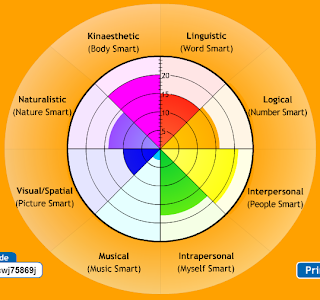Howard Gardner's theory of multiple intelligences has surfaced in my masters/credential program at USD in various courses and contexts. Basically Gardner developed a theory that people are strongly suited with one or more of nine intelligences: linguistic, logical/mathematical, musical/rhythmic, bodily/kinesthetic, spatial, intrapersonal, interpersonal, existential. To learn more about the theory of multiple intelligences and its' application to the classroom see the PBS site. Also, if you are not sure which intelligences are your strongest, then take this free online 40 question quiz. I took the quiz and it took me no longer than 5-7 minutes, and at the end it gives you a great graphic with your results. Here is mine:
From my results, it can be seen the my strengths lie in the following intelligences: kinesthetic, interpersonal, logical, ans intrapersonal. These intelligences are the kind that are best suited for high academic performance in the traditional classroom. School has always been something that I really enjoyed and excelled at. In the classroom I know that I must prepare lesson plans that will attempt to give more students a chance to tap into their specific strengths. Yet, I acknowledge that every lesson may not fully achieve this, I do hope the awareness will help me in lesson planning.
ZUMBA
For the past two weeks I have been taking a Zumba Fitness Dance Class, for one hour, once a week. For those who are unfamiliar with Zumba, it is a latin-fused mixture of music and dance with quick moves designed to work out your body. See the youtube video below for a look at what a Zumba class looks like:
As it can be seen from the results of my multiple intelligence quiz, my visual/spatial and musical intelligence is my weakest of intelligences. This is something that I have been aware of, but it was even more apparent in the Zumba class. I enjoy dancing as I please when I have the opportunity, but this was the first time since my quinceñera that I had to follow dance moves. Not only did I have to follow dance moves, but I had to pick it up quickly, because the moves are not slowed down or broken down. The result was me trying my best to follow the intrsutctor's moves. I found it to be very frustrating that no matter how hard I tried, or how much I focused, all my hard-work wasn't getting me the results I thought I deserved. I just was not able to perform at the level that I thought I should, considering how hard I was trying. This experience made me think about the element of "empathy" that Daniel Pink discusses in his book A Whole New Mind. After the Zumba experience, I started to think of students that are my opposite in regards to intelligences. All those students who are strongest in the spatial and musical intellgences, might be more prone to struggle in the traditional academic classroom. Sometimes, no matter how hard they work they might not achieve the results they think they deserve. The Zumba experience, also made me think about if the moves were slowed down, or chunked, then I think I could learn them. This experience made me see the importance of "chunking" material for students in a whole new light.

What a great connection of your frustrations in Zumba to students' frustrations in school! Sometimes it's hard to keep that empathy and understanding in mind when teaching, but if we can do it more our students will definitely benefit form it. Great insight!
ReplyDeleteYour experience in zumba is how I feel when I do art or draw something. I just try to do my best and now just be creative about it.
ReplyDelete